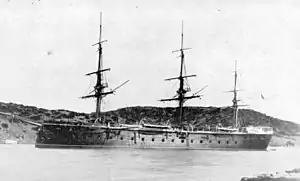Spanish ironclad Vitoria
The Spanish ironclad Vitoria was an iron-hulled armored frigate purchased from England during the 1860s.
 Vitoria in Mahón, c. 1885 | |
| History | |
|---|---|
| Name: | Vitoria |
| Namesake: | Battle of Vitoria |
| Ordered: | December 1862 |
| Builder: | Thames Ironworks, Blackwall, London |
| Laid down: | January 1863 |
| Launched: | 4 November 1865 |
| Completed: | May 1867 |
| Commissioned: | February 1868 |
| Stricken: | 1912 |
| Fate: | Scrapped, 1912 |
| General characteristics (as built) | |
| Type: | Broadside ironclad |
| Displacement: | 7,250 t (7,140 long tons) |
| Length: | 96.8 m (317 ft 7 in) |
| Beam: | 17.3 m (56 ft 9 in) |
| Draft: | 7.7 m (25 ft) |
| Installed power: | |
| Propulsion: | 1 shaft, Trunk steam engine |
| Sail plan: | Ship rig |
| Speed: | about 14 knots (26 km/h; 16 mph) |
| Range: | 2,400 nmi (4,400 km; 2,800 mi) at 10 knots (19 km/h; 12 mph) |
| Complement: | 561 |
| Armament: |
|
| Armor: | |
Design and description
.jpg.webp)
Vitoria was 96.8 meters (317 ft 7 in) long at the waterline, had a beam of 17.3 meters (56 ft 9 in) and a draft of 7.7 meters (25 ft 3 in).[1] She displaced 7,250 metric tons (7,135 long tons).[2] Her crew consisted of 561 officers and enlisted men.[1]
The ship was fitted with a pair of John Penn and Sons trunk steam engines that drove one propeller shaft using steam provided by eight cylindrical boilers. The engines were rated at a total of 1,000 nominal horsepower or 4,500 indicated horsepower (3,400 kW), and gave Vitoria a speed of 14 knots (26 km/h; 16 mph)[3] The ironclad carried a maximum of 875 metric tons (861 long tons) of coal[4] that gave her a range of 2,400 nautical miles (4,400 km; 2,800 mi) at 10 knots (19 km/h; 12 mph).[2] She was fitted with a three-masted ship rig with a sail area of around 1,800–1,900 square meters (19,000–20,000 sq ft).[5]
The frigate's main battery was originally intended to consist of thirty 200-millimeter (7.9 in) smoothbore guns mounted on the broadside, but she was fitted with four 229-millimeter (9 in) and three 200 mm Armstrong-Whitworth rifled muzzle-loading (RML) guns, and fourteen Trubia 160-millimeter (6.3 in) smoothbore guns. The 229 mm and 160 mm guns were situated on the gun deck while the 200 mm guns were positioned on the main deck, one on each broadside, and another in the forecastle as the forward chase gun. By 1883, the Trubia guns had been replaced by four more 229 mm guns. When Vitoria was refitted in France in 1896–1898, her armament was changed to six Hontoria 160 mm and eight Canet 140-millimeter (5.5 in) rifled breech-loading guns and a pair of 354-millimeter (14 in) torpedo tubes.[4][6]
Vitoria had a complete wrought iron waterline belt of 140 mm armor plates. Above the belt, the guns, except for the chase gun, were protected by 130-millimeter (5.1 in) of armor. The ends of the ship and the deck were unarmored.[4][7]
Footnotes
- de Saint Humber, p. 23
- Silverstone, p. 388
- de Saint Hubert, pp. 22–23
- Lyon, p. 380
- de Saint Hubert, pp. 22, 24
- de Saint Hubert, pp. 27–28
- de Saint Hubert, pp. 22–23
References
- Brassey, Thomas (1888). The Naval Annual 1887. Portsmouth, England: J. Griffin. OCLC 669097244.
- de Saint Hubert, Christian (1984). "Early Spanish Steam Warships, Part II". Warship International. XXI (1): 21–45. ISSN 0043-0374.
- Lyon, Hugh (1979). "Spain". In Chesneau, Roger & Kolesnik, Eugene M. (eds.). Conway's All the World's Fighting Ships 1860–1905. Greenwich, UK: Conway Maritime Press. pp. 380–386. ISBN 0-8317-0302-4.
- Pastor y Fernandez de Checa, M. (1977). "The Spanish Ironclads Numancia, Vitoria and Pelayo, Pt. II". F. P. D. S. Newsletter. Akron, Ohio: F. P. D. S. V (1): 3–5. OCLC 41554533.
- Silverstone, Paul H. (1984). Directory of the World's Capital Ships. New York: Hippocrene Books. ISBN 0-88254-979-0.
- "Spanish Ironclads Numancia and Vitoria". Warship International. VIII (3): 287–289. 1970.